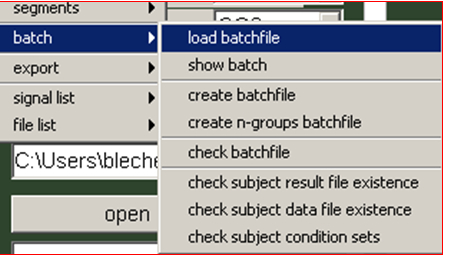recent files:
the recent files menuitem keep track of recently used data- , batch-
, interval- and settingsfiles, to simplify reusing and reloading often
needed files. Moreover, recently used study folders can be
selected.
segments:
Allows you to use existing timing files as 'overlay' over the data (allows you edit or view data only in intervals that are relevant for the analysis)
you can save and save segments to and load segments from any timing file. Intervals to save are taken from the currently loaded data and may have been created using the interval wizard or by mouse click.
setting
files:
(under construction)

batch:
the
batch menu item expands to the submenu:
load
batchfile: use this command to select a textfile, containing
the paths of your data files with one path per line. Paths must be
absolute and exact ( e.g C:\mydata\tex\raw\TEX00101.ACQ ). If
successful, anslab displays a confirmation dialog with the number of
valid filepaths found in the file.
show
batch: displays the currently loaded batch.
create
batchfile: batchfiles are needed
at various occasions when working with anslab.
You can create them by hand using any text-editor you like, but this is
a lot of tedious work and prone to typing errors. You can speed up the
process by using the 'create batchfile'-command which lets you enter a
search filter string (e.g.:<< *.txt >>, if you
wish to look only for textfiles) and choose a folder to search in.
Optionally you can choose to search subfolders of the start folder. The
filepaths of the files found are printed in the matlab command window
and written to a textfile.
create
n-groups batchfile: same as above, except that multiple
filters can be specified the create a batchfile that contains several
subgroups of files (needed for statistical analysis, averaging and
other tools).
check
subject file existence: scans the subfolders of a study folder
for analysis results corresponding a filematrix of raw data files and
writes a report in a textfile. Use this tool to verify, that analysis
results exist for all subjects, files and channels.
check subject condition:
sets: this tool analyzes a loaded filematrix for completeness:
for every subject found, condition averages are counted and listed,
allowing you to verify that all conditions exist for all subjects in
your filematrix.
export:
use the export menu to export traces to a text- or mat-file.
signal
list: use the signal list menu to delete, duplicate
or rename traces.
file list:
use the signal list menu to delete, duplicate
or rename traces.